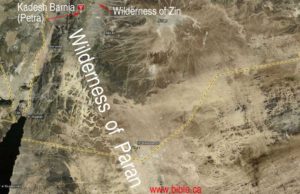“Adonai came from Sinai;
from Se‘ir he dawned on his people,
shone forth from Mount Pa’ran;
and with him were myriads of holy ones;
at his right hand
was a fiery law for them.”
-Deuteronomy 33:2
Moses’ final farewell address to the children of Israel is actually quite reminiscent of the blessings Jacob pronounced upon his sons on his deathbed (as recorded in the closing chapters of the book of Genesis).
And just like the blessings of Jacob were actually an ad hoc mixture of different topics and both blessings and curses, so too does Moses’ blessings take on a variety of different forms and topics.
Moses’ speech here in Deuteronomy chapter 33 includes pronouncements resembling the ordination to establish the firstborn as the new ruler over Israel as well as other declarations focusing on the future of Israel.
However, the vast majority of Moses’ blessings will focus on the tribes of Israel based on the individual territory each would be assigned inside the land of Canaan.
In this prayer, Moses asks that Hashem will secure the destinies of each tribe and that they would be supernaturally protected from their enemies.
First, we see in the opening verse that Moses gives due credit to whom it is due: the Lord their God who rescued them from Egypt.
We’re presented some interesting imagery in the opening verses of this prayer.
A picture is painted of a wonderfully ferocious, swift and powerful Savior descending from the wilderness regions located south of the land of Canaan to rescue the Hebrews from the hands of Pharaoh in Egypt.
These verses are referring to Sinai and Seir in the land of Edom.
In other words, we’re specifically talking about the mountainous regions of the Sinai Peninsula and Seir.
Although most Bibles will use the term “Mount Paran”, that’s not accurate because no one has ever discovered one singular mountain peak called “Mount Paran”.
It would be more accurate to say the mountains of Paran (in the plural).
Note the part of verse 2 where it says…
…“and with him were myriads of holy ones“.
In our Bibles we’ll normally find a footnote accompanying this verse telling us that…
…“The meaning of the Hebrew for this phrase is uncertain”.
Why?
Well, because it is uncertain and here’s where we run into another conflict between the Dead Sea Scrolls and the Septuagint…
…AND…
…the Masoretic Texts.
In the Dead Sea Scrolls and Septuagint (the first Greek translation of the Tanakh), this verse references a place called RIBEBOTH-KODESH.
However, it’s not interpreted that way in the Masoretic Texts.
RIBEBOTH means “myriads” and KODESH means “holy”.
Although RIBEBOTH-KODESH is referring to a physical location, the majority of Bible translations which use the Masoretic Text as their source document take a very different spin on the meaning of this verse.
They take the phrase RIBEBOTH-KODESH and turn it into the phrase “myriads of holy ones”.
Like what in the heck does that even mean?
We’re given this image of countless angelic beings.
So again we have another $64,000 question.
Which interpretation is correct?
Is RIBEBOTH-KODESH referring to an actual physical location or the ambiguous as all hell “myriads of holy ones”.
The answer is that RIBEBOTH-KODESH is referring to a location and all the other vast majority of English Bible translations in existence are wrong (yup, I said it).
Why?
Because it doesn’t make any darn sense to say Hashem approached the land of Canaan from myriads of angels or “holy ones” when the entire context of this passage is all about the desert territory the Hebrews had to travel through in order to get to the Promised Land.
Got it homies?
Therefore, this is speaking about a physical location near KADESH that is located inside the Wilderness of Paran which borders Seir.
I’m done.




Leave a Reply